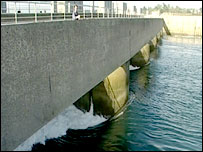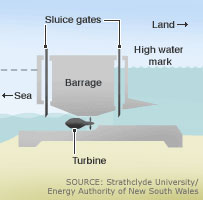
Tidal barrage moves a step closer
May 23, 2007 - BBC
Plans for a £14bn barrage that would harness the
tidal energy of the Severn estuary have taken a step
forward.
UK Trade Secretary Alistair Darling said
tidal power was "in its infancy" but the government
wanted to encourage its development. Stretching from
south of Cardiff to Weston-super-Mare in Somerset,
the barrage could supply 5% of the UK's electricity,
according to supporters. But some environmentalists
fear its impact on wildlife and their habitats. The
energy white paper was published in a statement by
Mr Darling in the Commons on Wednesday. He said that
he wanted to encourage tidal power but acknowledged
that there were environmental hurdles to overcome.
Mr Darling said that the government needed to weigh-up
the impact a barrage might have on the environment
with the impact further carbon emissions would have
on that environment. "I think one of the environmental
issues that has not yet been properly addressed is
the balance to be struck between the impact on say,
the River Severn, and the environmental gain that
would come from not putting more and more carbon into
the atmosphere," he said. The 10-mile (16km) barrage
has been mooted in different forms since it was first
proposed in 1849, according to Roger Falconer, professor
of hydro-environmental engineering at Cardiff University.
|
Severn
Barrage
|
 |
|
The barrage would be 16km
(10 miles) long
It would power more than 200
turbines
Planners say it could create
35,000 construction jobs and between 10,000
and 40,000 permanent jobs
The barrage could be generating
electricity within 11 years, say planners
|
In 1981, the first major study of the environmental
impact of such a scheme was carried out with further
research in 1989, he said.
Last week, 24 MPs signed
an early day motion calling on the government to urgently
reappraise the idea. The current Severn tidal barrage
proposal would stretch across the Bristol Channel
from Lavernock Point near Penarth to Brean Down near
Weston-Super-Mare. "They have always been looking
for ways to produce energy," said Professor Falconer.
"With recent issues such as renewable energy and commitment
to the Kyoto (Protocol), it is much more of a concern."
Welsh Secretary Peter Hain welcomed the announcement
and said "full consideration" would be given to Welsh
interests and concerns before any proposals were taken
forward. He said: "With the huge threat of climate
change, it is only through clean, green alternatives,
from household solar panels to large-scale schemes
such as the Severn barrage, that we can make the necessary
reductions in our carbon emissions." The barrage would
work similarly to a dam, he explained, which generates
hydro electric power by holding water back before
it is allowed to flow at speed through a pipe at the
base of the dam to drive the turbines.
|
How Tide
Power Works
|
 |
|
As tide comes in, sea water
passes through barrage to landward side
At high tide, sluice gates
shut, trapping water in estuary or basin
When tide recedes on sea-side
of barrage, sluice gates open
Water flows through barrage,
driving turbines and generating power
Power can be generated in
both directions, but this can affect efficiency
and economics of project
|
As well as powering around 200 turbines, the barrage
would feature "sluices" which allow water to go one
way or another and locks to let ships pass.
The site is attractive for the project because it
has the second highest tidal range in the world, behind
the Bay of Fundy in Canada.
"There has been a big change in public opinion,"
said Professor Falconer. "I'm not saying it will be
built but the case for further studies is a strong
one. I think we will see a major reappraisal of this
project."
Roger Hull, spokesman for the Severn
Tidal Power Group which is promoting the proposal,
said much had changed since the studies of the 1980s
and it was time the barrage was "thought about again".
"Prices of fossil fuels have gone up, the environment
has changed, legislation has changed, the way we sell
electricity has changed and the security of supply
is a bigger issue," he said. While the barrage would
change the local environment and certain birds would
probably have to move elsewhere, he said, positive
environmental impacts would include saving on greenhouse
gas emissions and increased flood protection.
A transport link across the top of the barrage would
be another benefit for the south West of England and
south Wales, he added.

|